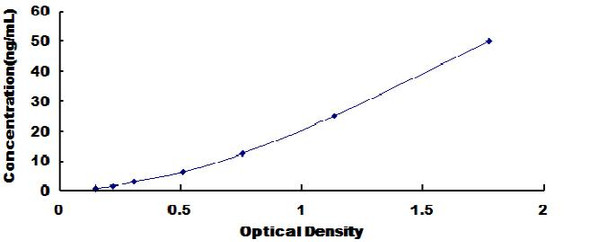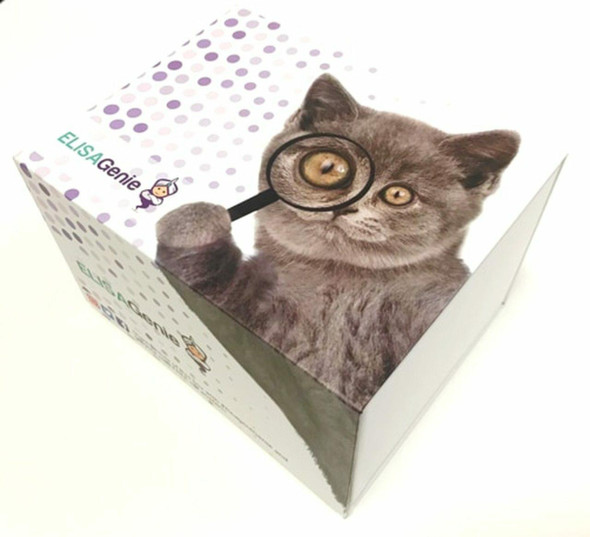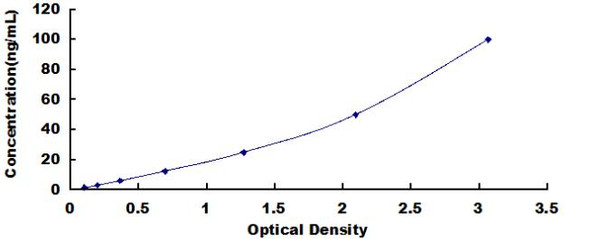Mouse NAGase (N-Acetyl Beta-D-Glucosaminidase) ELISA Kit (MOES01284)
- SKU:
- MOES01284
- Product Type:
- ELISA Kit
- Size:
- 96 Assays
- Uniprot:
- Q9EQQ9
- Sensitivity:
- 0.47ng/mL
- Range:
- 0.78-50ng/mL
- ELISA Type:
- Sandwich
- Synonyms:
- N-Acetylhexosaminidase, beta-D-N-acetylhexosaminidase, beta-N-acetyl-D-hexosaminidase
- Reactivity:
- Mouse
- Sample Type:
- Serum, plasma and other biological fluids
Description
Mouse NAGase (N-Acetyl Beta-D-Glucosaminidase) ELISA Kit
The Mouse Nagase N-Acetyl-beta-D-Glucosaminidase ELISA Kit is a highly sensitive and specific assay designed for the accurate detection of NAG levels in mouse serum, plasma, and cell culture supernatants. This kit ensures reliable and reproducible results, making it ideal for a variety of research applications.N-Acetyl-beta-D-Glucosaminidase (NAG) is an important enzyme involved in the breakdown of glycosaminoglycans and plays a role in various physiological and pathological processes.
Elevated levels of NAG have been associated with conditions such as kidney disease, inflammation, and certain cancers, making it a valuable biomarker for studying these conditions and developing potential therapies.Overall, the Mouse Nagase N-Acetyl-beta-D-Glucosaminidase ELISA Kit provides researchers with a powerful tool for accurately measuring NAG levels in mouse samples, advancing our understanding of the role of this enzyme in health and disease.
| Assay type: | Sandwich |
| Format: | 96T |
| Assay time: | 4.5h |
| Reactivity: | Mouse |
| Detection Method: | Colormetric |
| Detection Range: | 0.78-50 ng/mL |
| Sensitivity: | 0.47 ng/mL |
| Sample Volume Required Per Well: | 100µL |
| Sample Type: | Serum, plasma and other biological fluids |
| Specificity: | This kit recognizes Mouse NAGase in samples. No significant cross-reactivity or interference between Mouse NAGase and analogues was observed. |
This ELISA kit uses Sandwich-ELISA as the method. The micro ELISA plate provided in this kit has been pre-coated with an antibody specific to Mouse NAGase. Standards or samples are added to the appropriate micro ELISA plate wells and combined with the specific antibody. Then a biotinylated detection antibody specific for Mouse NAGase and Avidin-Horseradish Peroxidase (HRP) conjugate are added to each micro plate well successively and incubated. Free components are washed away. The substrate solution is added to each well. Only those wells that contain Mouse NAGase, biotinylated detection antibody and Avidin-HRP conjugate will appear blue in color. The enzyme-substrate reaction is terminated by adding Stop Solution and the color turns yellow. The optical density (OD) is measured spectrophotometrically at a wavelength of 450 nm ± 2 nm. The OD value is proportional to the concentration of Mouse NAGase. The concentration of Mouse NAGase in samples can be calculated by comparing the OD of the samples to the standard curve.
| UniProt Protein Function: | Isoform 1: Cleaves GlcNAc but not GalNAc from O-glycosylated proteins. Can use p-nitrophenyl-beta-GlcNAc and 4-methylumbelliferone-GlcNAc as substrates but not p-nitrophenyl-beta-GalNAc or p-nitrophenyl-alpha-GlcNAc (in vitro) (PubMed:11148210). Does not bind acetyl-CoA and does not have histone acetyltransferase activity (PubMed:24088714). |
| NCBI Summary: | The dynamic modification of cytoplasmic and nuclear proteins by O-linked N-acetylglucosamine (O-GlcNAc) addition and removal on serine and threonine residues is catalyzed by OGT (MIM 300255), which adds O-GlcNAc, and MGEA5, a glycosidase that removes O-GlcNAc modifications (Gao et al. , 2001 [PubMed 11148210]). [supplied by OMIM, Mar 2008] |
| UniProt Code: | Q9EQQ9 |
| NCBI GenInfo Identifier: | 215490056 |
| NCBI Gene ID: | 10724 |
| NCBI Accession: | NP_001135906. 1 |
| UniProt Secondary Accession: | Q9EQQ9,Q9EQQ9, Q8VIJ5, |
| UniProt Related Accession: | O60502 |
| Molecular Weight: | 96,932 Da |
| NCBI Full Name: | protein O-GlcNAcase isoform b |
| NCBI Synonym Full Names: | meningioma expressed antigen 5 (hyaluronidase) |
| NCBI Official Symbol: | MGEA5 |
| NCBI Official Synonym Symbols: | OGA; MEA5; NCOAT |
| NCBI Protein Information: | protein O-GlcNAcase |
| UniProt Protein Name: | Protein O-GlcNAcase |
| UniProt Synonym Protein Names: | Beta-N-acetylglucosaminidase |
| UniProt Gene Name: | MGEA5 |
As the OD values of the standard curve may vary according to the conditions of the actual assay performance (e. g. operator, pipetting technique, washing technique or temperature effects), the operator should establish a standard curve for each test. Typical standard curve and data is provided below for reference only.
| Concentration (ng/mL) | O.D | Average | Corrected |
| 50 | 2.29 2.344 | 2.317 | 2.249 |
| 25 | 1.637 1.663 | 1.65 | 1.582 |
| 12.5 | 0.945 0.915 | 0.93 | 0.862 |
| 6.25 | 0.456 0.49 | 0.473 | 0.405 |
| 3.13 | 0.252 0.23 | 0.241 | 0.173 |
| 1.57 | 0.182 0.154 | 0.168 | 0.1 |
| 0.78 | 0.112 0.126 | 0.119 | 0.051 |
| 0 | 0.066 0.07 | 0.068 | -- |
Precision
Intra-assay Precision (Precision within an assay): 3 samples with low, mid range and high level Mouse NAGase were tested 20 times on one plate, respectively.
Inter-assay Precision (Precision between assays): 3 samples with low, mid range and high level Mouse NAGase were tested on 3 different plates, 20 replicates in each plate.
| Intra-assay Precision | Inter-assay Precision | |||||
| Sample | 1 | 2 | 3 | 1 | 2 | 3 |
| n | 20 | 20 | 20 | 20 | 20 | 20 |
| Mean (ng/mL) | 2.46 | 5.80 | 19.22 | 2.40 | 5.49 | 20.68 |
| Standard deviation | 0.14 | 0.31 | 0.90 | 0.13 | 0.32 | 0.65 |
| C V (%) | 5.69 | 5.34 | 4.68 | 5.42 | 5.83 | 3.14 |
Recovery
The recovery of Mouse NAGase spiked at three different levels in samples throughout the range of the assay was evaluated in various matrices.
| Sample Type | Range (%) | Average Recovery (%) |
| Serum (n=5) | 90-105 | 96 |
| EDTA plasma (n=5) | 87-102 | 94 |
| Cell culture media (n=5) | 89-101 | 96 |
Linearity
Samples were spiked with high concentrations of Mouse NAGase and diluted with Reference Standard & Sample Diluent to produce samples with values within the range of the assay.
| Serum (n=5) | EDTA plasma (n=5) | Cell culture media (n=5) | ||
| 1:2 | Range (%) | 87-101 | 95-111 | 95-108 |
| Average (%) | 93 | 102 | 102 | |
| 1:4 | Range (%) | 87-99 | 85-98 | 89-104 |
| Average (%) | 93 | 90 | 95 | |
| 1:8 | Range (%) | 91-108 | 84-98 | 82-94 |
| Average (%) | 98 | 89 | 88 | |
| 1:16 | Range (%) | 90-101 | 83-96 | 81-93 |
| Average (%) | 96 | 88 | 88 |
An unopened kit can be stored at 4°C for 1 month. If the kit is not used within 1 month, store the items separately according to the following conditions once the kit is received.
| Item | Specifications | Storage |
| Micro ELISA Plate(Dismountable) | 8 wells ×12 strips | -20°C, 6 months |
| Reference Standard | 2 vials | |
| Concentrated Biotinylated Detection Ab (100×) | 1 vial, 120 µL | |
| Concentrated HRP Conjugate (100×) | 1 vial, 120 µL | -20°C(shading light), 6 months |
| Reference Standard & Sample Diluent | 1 vial, 20 mL | 4°C, 6 months |
| Biotinylated Detection Ab Diluent | 1 vial, 14 mL | |
| HRP Conjugate Diluent | 1 vial, 14 mL | |
| Concentrated Wash Buffer (25×) | 1 vial, 30 mL | |
| Substrate Reagent | 1 vial, 10 mL | 4°C(shading light) |
| Stop Solution | 1 vial, 10 mL | 4°C |
| Plate Sealer | 5 pieces | |
| Product Description | 1 copy | |
| Certificate of Analysis | 1 copy |
- Set standard, test sample and control (zero) wells on the pre-coated plate and record theirpositions. It is recommended to measure each standard and sample in duplicate. Note: addall solutions to the bottom of the plate wells while avoiding contact with the well walls. Ensuresolutions do not foam when adding to the wells.
- Aliquot 100µl of standard solutions into the standard wells.
- Add 100µl of Sample / Standard dilution buffer into the control (zero) well.
- Add 100µl of properly diluted sample (serum, plasma, tissue homogenates and otherbiological fluids) into test sample wells.
- Cover the plate with the sealer provided in the kit and incubate for 90 min at 37°C.
- Aspirate the liquid from each well, do not wash. Immediately add 100µL of BiotinylatedDetection Ab working solution to each well. Cover the plate with a plate seal and gently mix. Incubate for 1 hour at 37°C.
- Aspirate or decant the solution from the plate and add 350µL of wash buffer to each welland incubate for 1-2 minutes at room temperature. Aspirate the solution from each well andclap the plate on absorbent filter paper to dry. Repeat this process 3 times. Note: a microplatewasher can be used in this step and other wash steps.
- Add 100µL of HRP Conjugate working solution to each well. Cover with a plate seal andincubate for 30 min at 37°C.
- Aspirate or decant the solution from each well. Repeat the wash process for five times asconducted in step 7.
- Add 90µL of Substrate Reagent to each well. Cover with a new plate seal and incubate forapproximately 15 min at 37°C. Protect the plate from light. Note: the reaction time can beshortened or extended according to the actual color change, but not by more than 30min.
- Add 50 µL of Stop Solution to each well. Note: Adding the stop solution should be done inthe same order as the substrate solution.
- Determine the optical density (OD value) of each well immediately with a microplate readerset at 450 nm.








